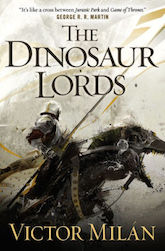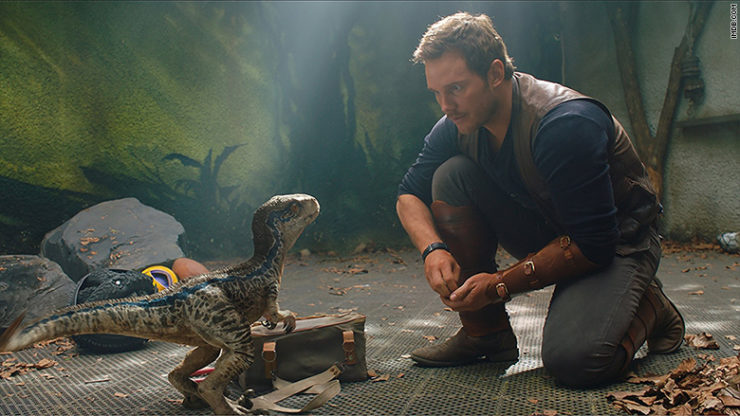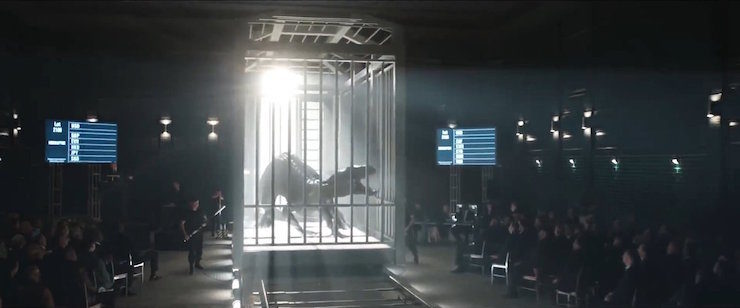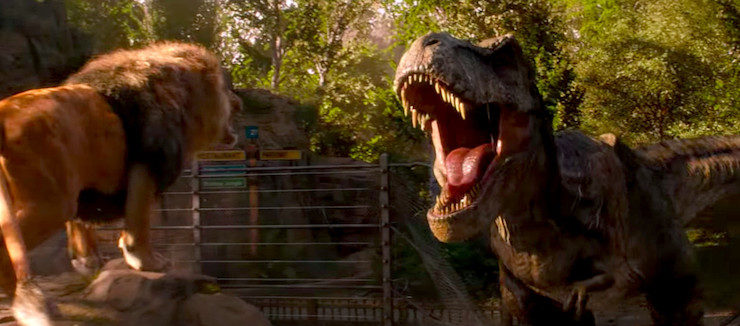When Michael Crichton wrote Jurassic Park in the late ’80s, he pulled from a wide range of biological knowledge at the time to envision a (surprisingly) realistic picture of what bringing back an extinct species, like a dinosaur, might look like. To bring one back from the dead would require methods from genetics, molecular biology, genomics, and cell biology (to name a few), and to set them up to survive would require knowledge of ecology and evolution. On top of that, creating a suitable habitat would require numerous other disciplines including botany, paleontology, mathematics and computer science. Finally, if one adds in the additional complications of turning the whole thing into an amusement park to generate enough funds to keep the whole thing going, it’s no wonder Dr. Malcolm kept going on and on about the danger of inherent instabilities in complex systems. In the end, Dr. Malcolm turned out to be right, and the smart money was absolutely on life finding a way.
[Warning: contains spoilers for Jurassic World: Fallen Kingdom]
After life got a little too proactive about finding its way in Jurassic World, the dinosaurs are once again facing their extinction—this time due to an impending volcanic eruption. Some hand-wringing ensues, some people with money and some people with bad intentions hatch a plan, said plans fail, and in the end, the handful of rescued dinosaurs get loose in Northern California, complete with an all-too brief Dr. Malcolm cameo where he once again warns us about the dangers of our own hubris. Except this time, it’s not about the folly of thinking one can control life. This time, it’s about the extinction of humanity itself.
But should humanity really be worried about dinosaurs re-entering the mix of life on the planet, or is it the dinosaurs who should be worried? After all, the dinosaurs that escaped Lockwood’s compound face a number of very real challenges in their re-entry into the general population of the planet, first and foremost being:
Minimum viable population is a thing.
In conservation biology, the idea of minimum viable population puts odds on the survival of a species over time given there are a certain minimum number of individuals. These odds include consideration of the unique challenges that population faces, such as natural disasters, climate change, or genetic problems. For example, a population of 50 giant pandas—given inbreeding, destruction of their natural habitats and likelihoods of other natural disasters—have a 70% chance of surviving out 100 years. Increase that number to 60 pandas and you have a 96% chance. Unfortunately for our dinos, only a handful of individuals from about a dozen species were recovered from the island before it exploded, so even with some generous statistical scenarios being applied, the odds aren’t good when you only have two or three individuals to start with. Furthermore:
They are all descendants of clones.
When InGen pieced together the genomes of these existing dinosaurs from samples taken from amber-encased ancient mosquitos, they had to take some creative license with the sequences because there simply wasn’t enough source material to be sure of every single one of the billions of base pairs in a given dino genome. After all, InGen was at the mercy of what ancient mosquitos they could find, meaning they only had one or maybe a handful of source samples per species, and they still didn’t have enough of the genomes covered to not have to resort to copying and pasting sequences from other species to fill in the blanks. What this means is that these species were forced through an extremely narrow 65 million year bottleneck, and are now severely lacking in genetic diversity, which is a problem because:
Genetic diversity is what allows a species to adapt to its environment.
Genetic diversity is the thing that enables life to find a way. It’s the thing that allows enough variation in traits to cope with sudden selective pressures, such as maybe being suddenly transported from a warm, equatorial climate to an unfamiliar temperate ecology, full of unfamiliar food sources, new diseases and predators. A good example of this is the problems with monoculture crops, which are essentially genetically identical seed stocks that have been engineered to have resistance to a particular environmental stress, like a pest. There has always been a genetic arms race between plants and their pathogens, i.e. prey and their predators. Pests over time will usually develop spontaneous mutations that enable them to eat such crops. In the wild, there’s usually enough spontaneous diversity in a plant species that new kinds of resistance to that pest will pop up. But in a monoclonal crop, once a pathogen gets around an engineered defense, that entire variety is now at risk of collapse. It’s happened with countless crop species in the past, and will happen again. Our dinos face a similar threat—being clones, they are extremely susceptible to environmental stresses (climate, pathogens, toxins, etc.), and the only way to increase diversity would be for an outside population to come in to breed, or to wait long enough for mutations to spontaneously arise and increase diversity naturally. In the case of our dino friends, unless all those Victorian Lost World tales turn out to be true, or they’ve got a few thousand years to spare, the odds aren’t looking good, especially considering:
They are no longer a geographically isolated population.
Jurassic Park was designed as a nature preserve where the dinosaurs could be protected from a world they haven’t evolved to exist in. Given enough time and research, there might have been some hope of the dinosaur populations better adapting to a world where the average global temperature and oxygen levels are significantly lower than when they were alive. Additionally, there were no natural predators (aside from other dinos) and they got frequent check ups from medical professionals if they got sick or injured, and everything about their lives were controlled. Now there is no more medical assistance and they are subject to a wildly different climate with different flora and fauna, different diseases and microbes and no one to watch over them. Which is a serious problem because:
They have been plunked down into an entirely new ecological niche.
Ecological niches consist of all of the flora and fauna within a particular area that have all been evolving together over long periods of time. Often, these niches have certain checks and balances built in—say, if an organism mutates so that it proliferates to higher numbers than the niche can support, that population will frequently over-consume to the point of starvation, then die back to more sustainable numbers, or perhaps the niche contains an adaptation that enable it support of those higher numbers, or perhaps the niche will completely collapse and have to start all over again. Additional problems arise when invasive species arrive in a niche and cause similar unbalances, where either the invasive species collapses, the ecology does, or an eventual balance is found. An example of this is the brown tree snake, which was introduced from the South Pacific to Guam after World War II. Due to the abundant prey and lack of effective natural predators, the snakes brought about the local extinction of most of the vertebrate species (including birds and pets), as well as causing numerous power outages when they climb utility poles. Because Guam is a major hub in the Pacific, dogs are used to check all cargo going out of the island to ensure no tree snakes are hitching a ride elsewhere.
Buy the Book


The Dinosaur Lords
The problem of introducing dinosaurs into any ecology on earth is that these dinosaurs haven’t been evolving alongside the species they’re now having to live with. Take our example above with the plant/pathogen arms race—the same has been going on with herbivores and plants. Plants keep evolving new compounds to help prevent animals from eating them, and animals keep evolving ways to nullify those defensive efforts. It is unclear if the herbivorous dinosaurs can even eat the native plants in their new Northern California habitat without becoming so sick they die or so sick they become easy prey to predators. Not to mention they’ll have the same problems with being an invasive species as above—over-consume and starve to death, or the niche defends itself and the herbivores die. Furthermore, the predators face entirely different challenges having to compete with other predators for game. If they eat too much game, they run out of food and starve, or if they’re too close to other predators, they might have to fight off that predator until only one is left standing. Furthermore, even if the predators wind up spreading out, it makes finding a mate much more challenging, particularly if there are only one or two of your species left on earth. Not to mention they have to deal with the biggest threat to their existence they’ve ever faced:
Humans are the worst.
Sure, some humans will always try to save and protect a dying species, but as we can see from everything above, the dinosaurs are still going to have an exceptionally bad time. The larger predators would be easy to find, and humans are all kinds of curious and have all kinds of weapons (of self defense and of sport) that can take down a dinosaur, no matter how thick its hide or well it can camouflage itself. If any of these animals stand a chance of surviving in the wild, it’s the smaller, quicker ones, but that’s only if they manage to overcome their lack of genetic diversity and the threats from their new environment for long enough to establish a big enough population. Only then they might have bought themselves enough time for diversity to begin to arise again within them.
Malcolm’s right about there being a threat of extinction to humanity, but it’s not because of this small number of dinosaurs. It seems the only way to ensure their survival is to approach it like the conservation problem it is—to rounding up what dinosaurs we can and put them into a protected preserve, like Lockwood had wanted and Hammond before him. There we can limit their exposure to environmental pressures, and care for them when they’re sick and injured. We’ll have to do it some place away from hunters, though, maybe on an island that more closely resembles their naturally warmer climate. But this venture would cost a lot of money, and would cost more and more the more animals we successfully kept alive to breed, so it might be worth opening it to the public to generate some cash to keep it operating, and maybe add some attractions to get people to keep coming back. Maybe we can call it something like… Jurassic Park.
Kelly Lagor is a scientist by day and a science fiction writer by night. Her work has appeared at Tor.com and other places, and you can find her tweeting about all kinds of nonsense @klagor













